Spend Your Holiday "Mending Fences"!
by Liz Hearn
When one thinks of the National Trust, one tends to think of buildings -- manors, museums, and simple cottages and town buildings that one can explore to learn more about Britain's past. However, the National Trust also owns the lands around many of those buildings -- including hundreds of miles of dry stone walls that surround those lands, marking property lines and fields. The Trust is committed to repairing, replacing, and rebuilding those walls to the old standards, so that they continue to fit the landscape.
Good Walls Make Good Vacations
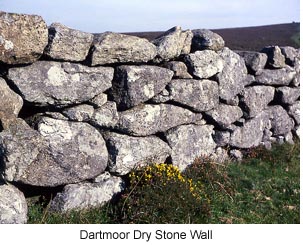 If you're looking for a holiday that includes more than just
sight-seeing, you can become part of this effort. The National
Trust Working Holidays Program has a broad spectrum of
countryside management work. The National Trust recognizes the
value of the old styles of field boundaries and encourages
volunteers to learn a new skill and share the experience of
replacing and conserving old hedges and walls using the old ways.
To build a new wall or replace an old one is to be part of the
future heritage of Britain by honoring the old traditions. Plus,
a week of volunteering will earn you a chance to experience Trust
properties behind the scenes, along with an Annual Free Entry
Pass.
If you're looking for a holiday that includes more than just
sight-seeing, you can become part of this effort. The National
Trust Working Holidays Program has a broad spectrum of
countryside management work. The National Trust recognizes the
value of the old styles of field boundaries and encourages
volunteers to learn a new skill and share the experience of
replacing and conserving old hedges and walls using the old ways.
To build a new wall or replace an old one is to be part of the
future heritage of Britain by honoring the old traditions. Plus,
a week of volunteering will earn you a chance to experience Trust
properties behind the scenes, along with an Annual Free Entry
Pass.
Many of the old hedges and walls resulted from the Enclosures
Acts of the 1750's onwards. The Acts encouraged land owners to
farm strips of land in one place by joining together with
neighboring strips of land, bringing efficiency to grain
production. The General Enclosures Acts of 1801 and 1836
simplified the process of enclosure and allowed farmers to
enclose common land or waste land previously unfarmed. Ironically
the fences, ditches, walls and hedges defining the new enclosures
are likely to have been built by poor tenant farmers who were
dispossessed of their lands by the process.
The different regions of the UK use different styles most suited
to the kind of stone or regional techniques handed down from one
generation to the next. You'll learn a whole new language for dry
stone walling. In Scotland they are 'dry stane dykes' and in
Cornwall in the far south west, though made of stone, the walls
are called 'Cornish hedges'. There are stones at the bottom
called 'footers', stones that run through the wall called
'throughs', little stones to fill the middle called 'heartings'
and 'coping' stones to finish off the top.
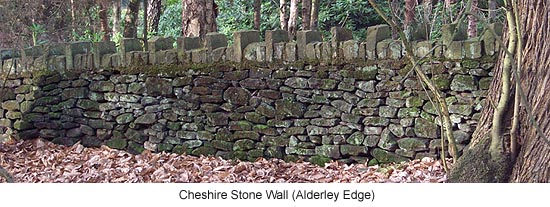
The different styles used in each region result from the
different kinds of stone found in each area. Stone is expensive
to move very far, so local field pickings are used first,
followed by locally quarried stone. In areas where only large
boulders can be found, the walls are thick and look rather
jumbled up and chaotic. In areas where the most common stone is
slate (which is thin and falls apart easily), you're likely to
see the herringbone pattern of stacking plates of stone
diagonally. This type of wall is seen most often in Devon and
Cornwall. If the slate is more robust then walls are more
regular, with the flat slate sitting horizontally. This is often
used in the Lake District. In the beautiful Cotswolds area and
parts of Yorkshire the stone is limestone, where the golden
yellow color of a new built wall ages to a wonderful golden grey
color. The regular-shaped stone makes regular-looking walls with
even layers throughout. In some areas, there are not enough large
stones to place at the top as coping stones, so different methods
of keeping the water out of the top of the wall are used. Some
regions use a layer of turf grass to keep out the water, which
might otherwise freeze within the wall during the winter, and
cause the wall to break apart.
The cross section shape of the wall is another regional design
features. A dry stone wall is nearly always a combination of two
walls standing back to back and interlocking with each other.
Before starting a section of wall, special 'A' frames, usually
made from wood, are positioned at each end of the section being
built. Between the two frames on each side of the wall a string
is stretched. This ensures that the wall does not deviate along
its length but remains straight and that each course remains
level as well. It also gives the taper width, or 'batter', of
the wall as it gets higher.
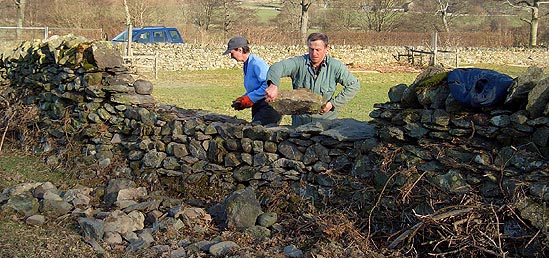
A good wall has courses of stone that run horizontal rather than
parallel to the hillside. This is best seen in the Welsh slate
walls or Lake District walls, where walls can run straight up a
steep hillside. The height of the wall remains the same but the
stones are all horizontal, each layer stepping into the hillside
a bit further as the wall goes up the hill. You always start this
kind of wall at the bottom of the hill and work upwards.
There are some simple principles in building a wall using stones
and no mortar. The bigger rocks go at the bottom and that the
stones become gradually smaller as you move towards the top. The
footers must be as firm and rigid as possible in the bottom of
the foundation trench. This can be the hardest part of the job.
Any slight wobble in the bottom of the wall translates to a big
wobble at the top, which can bring the whole wall tumbling down.
Stones can be wedged from the back to stop wobble as you work up
the wall. This is preferable to pinning stones underneath the
front, as these can be pushed out by frost. Each stone should
try to cross the joints of the layer of stones below. If a
tapered wall is being built, each stone should have a nice front
face that slopes nicely with the wall. If you are using old
stone, the facing side should be the one with all the moss or
lichen, as this is the side that has previously seen sunlight and
it makes for a nicer looking wall. You also need to keep the top
of each layer as flat and even as possible, as this makes the
next layer much easier to lay. A well built wall can stand firm
for several hundred years.
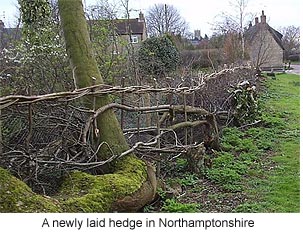 Hedge laying
is an activity carried out in winter months when the trees in a
mature hedge are dormant. The trunks of the small trees in the
hedge line are cut almost through and the trunk pushed over so
that it lies on its side along the length of the hedge. It is
then passed in a weaving pattern left and right through upright
stakes, making a basket weave. Each tree is laid on top of the
next along the hedge. In spring when the new growth comes, the
severe pruning the trees received causes new branches and shoots
to fill in all the gaps with a thick, bushy, impenetrable
hedge. Hedge laying
is an activity carried out in winter months when the trees in a
mature hedge are dormant. The trunks of the small trees in the
hedge line are cut almost through and the trunk pushed over so
that it lies on its side along the length of the hedge. It is
then passed in a weaving pattern left and right through upright
stakes, making a basket weave. Each tree is laid on top of the
next along the hedge. In spring when the new growth comes, the
severe pruning the trees received causes new branches and shoots
to fill in all the gaps with a thick, bushy, impenetrable
hedge.
The primary tool for hedge-laying is the "billhook," a type of
hand-axe. Each region has its own special shape and style of
billhook. A Yorkshire Billhook has two cutting edges with long
blades and a long handle, whereas a Staffordshire has a shorter
handle and blade and a Southern Counties Billhook has only one
blade. By the end of a week of hedge-laying, you will be able to
wield a billhook with skill.
Choosing a Working Holiday
Working Holidays are a great way to experience an old estate from
the inside. A week's volunteer holiday costs about £60. In some
regions long weekends are also available. You stay in basic
dormitory style bunk house accommodation in what is often a
converted stable block or barn on the estate. Facilities vary
depending upon location. In the colder months the communal lounge
area often has a cozy fire or wood-burning stove.
The types of holidays are coded to allow you to choose the best
project for you. You can choose which age group you would feel
most comfortable with, or choose your preferred type of task,
such as 'construction' or 'archeaolgical' projects. Task-related
skills are always appreciated but not always necessary so novices
are also welcomed.
A work team usually consists of up to twelve people, including a
trained volunteer leader, who organizes the food and an evening
social program. Most people attend a Working Holiday on their own
or as a couple. This means everyone has to learn to work together
to achieve the weeks task. You share cooking and cleaning chores
with the group. Working outdoors and doing physical work builds
up a great appetite so the food is basic and plentiful -- so
don't plan on losing weight with all that extra exercise.
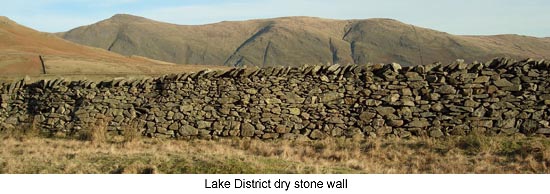
The working day is usually from 9am until 5pm with a break for
lunch and regular tea breaks. Tasks like dry stone walling and
hedging are skilled, so there are expert National Trust staff to
teach you the skills you need and then coach you as you try them
out for yourself. The week is not all work, though. A half day
off in the middle of the week often enables you to visit the
local town and sights. There is also usually an opportunity
during the week to visit the 'Big House' on the estate. Local
National Trust staff members are very knowledgeable about their
little corner of England. There are some interesting characters
to be met with stories to tell if you have time to listen.
There is a huge sense of achievement to be gained in making an
active contribution to conservation work. Working Holidays are a
great opportunity to meet new people in a more interactive way.
They are certainly a great way to make a connection with a place.
At the end of the week you will have made some good new friends,
learned a new skill and helped to maintain part of England's
future environmental heritage.
Getting Started
The National Trust is one of the largest landowners in the United
Kingdom. It owns and operates more than 300 historic houses and
612,000 acres of land including 600 miles of coastline. If
you join a Working Holiday for a week, however, you will receive
a free Annual Entry Pass.
The British Trust for Conservation Volunteers also offers a holiday program that provides opportunities to learn dry stone walling or hedge laying. They also publish books offering more information on this topic.
Related Articles:
- Holidays that Restore You -- and the Past, by Louise Simmons
- https://www.timetravel-britain.com/articles/travel/restore.shtml
- Conservation Holidays in the UK, by Tracy Kramer
- https://www.timetravel-britain.com/articles/travel/conservation.shtml
- Conserve Your Cash and Preserve the Past: English Heritage and the National Trust, by Dawn Copeman
- https://www.timetravel-britain.com/articles/travel/trust.shtml
More Information:
We regret that we no longer have the resources to maintain up-to-date links and/or hours and pricing details for the various sites and attractions listed on this website. For more information about the location(s) listed above, please use your favorite search engine or visit Wikipedia.
Liz Hearn is a British freelance writer
from the Wirral. She writes children's articles and travel
articles. Her articles have been published in Transitions
Abroad and Highlights for Children. She lives overseas
with her husband and small daughter and currently lives in
Beijing, China. She has volunteered for the National Trust for 15
years as a volunteer leader of Working Holidays and has learned a
new respect for the British rural landscape through active
participation in its conservation.
Article © 2005 Liz Hearn
Dartmoor wall © Moira Allen; hedge photos courtesy of Wikipedia.org; additional photos © John Bews.
| 